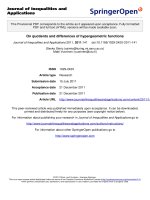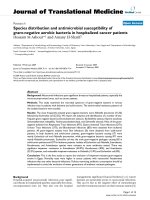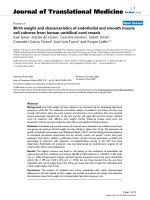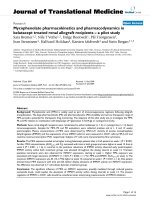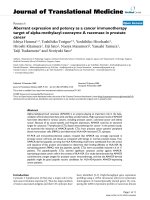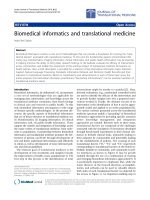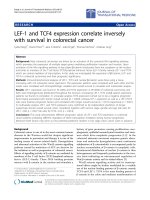báo cáo hóa học: " Surgical smoke and ultrafine particles" docx
Bạn đang xem bản rút gọn của tài liệu. Xem và tải ngay bản đầy đủ của tài liệu tại đây (584.12 KB, 6 trang )
BioMed Central
Page 1 of 6
(page number not for citation purposes)
Journal of Occupational Medicine
and Toxicology
Open Access
Research
Surgical smoke and ultrafine particles
Irene Brüske-Hohlfeld*
†1
, Gerhard Preissler
†2
, Karl-Walter Jauch
2
,
Mike Pitz
1,3
, Dennis Nowak
4
, Annette Peters
1
and H-Erich Wichmann
1,5
Address:
1
Helmholtz Zentrum München, German Research Center for Environmental Health, Institute of Epidemiology, Neuherberg, Germany,
2
Ludwig-Maximilians-University, Klinikum Grosshadern, Department of Surgery, München, Germany,
3
University of Augsburg, Center for Science
and Environment, Augsburg, Germany,
4
Ludwig-Maximilians-University, Institute and Outpatient Clinic for Occupational, Social and
Environmental Medicine, München, Germany and
5
IBE (Chair of Epidemiology, Ludwig-Maximilians-University) München, Germany
Email: Irene Brüske-Hohlfeld* - ; Gerhard Preissler - ; Karl-
Walter Jauch - ; Mike Pitz - ; Dennis Nowak -
muenchen.de; Annette Peters - ; H-Erich Wichmann -
* Corresponding author †Equal contributors
Abstract
Background: Electrocautery, laser tissue ablation, and ultrasonic scalpel tissue dissection all
generate a 'surgical smoke' containing ultrafine (<100 nm) and accumulation mode particles (< 1
μm). Epidemiological and toxicological studies have shown that exposure to particulate air
pollution is associated with adverse cardiovascular and respiratory health effects.
Methods: To measure the amount of generated particulates in 'surgical smoke' during different
surgical procedures and to quantify the particle number concentration for operation room
personnel a condensation particle counter (CPC, model 3007, TSI Inc.) was applied.
Results: Electro-cauterization and argon plasma tissue coagulation induced the production of very
high number concentration (> 100000 cm
-3
) of particles in the diameter range of 10 nm to 1 μm.
The peak concentration was confined to the immediate local surrounding of the production side.
In the presence of a very efficient air conditioning system the increment and decrement of ultrafine
particle occurrence was a matter of seconds, with accumulation of lower particle number
concentrations in the operation room for only a few minutes.
Conclusion: Our investigation showed a short term very high exposure to ultrafine particles for
surgeons and close assisting operating personnel – alternating with longer periods of low exposure.
Background
Since the 1990s epidemiological studies from the US and
Europe have shown that not only during smog episodes
[1], but even at times of relatively low ambient particulate
air pollution an increased morbidity and mortality from
cardiovascular and pulmonary diseases is observed. There
are different studies – including prospective cohort stud-
ies [2,3] – reporting associations between daily changes in
particulate air pollution and daily mortality [4,5]. An
excellent overview is given in the review by Pope and
Dockery [6].
Airborne particles are classified according to their aerody-
namic diameter: Particles with a diameter smaller than 10
μm (PM
10
) are inhalable and the coarse fraction –
between 2.5 and 10 μm – will deposit in the respiratory
Published: 3 December 2008
Journal of Occupational Medicine and Toxicology 2008, 3:31 doi:10.1186/1745-6673-3-31
Received: 11 June 2008
Accepted: 3 December 2008
This article is available from: />© 2008 Brüske-Hohlfeld et al; licensee BioMed Central Ltd.
This is an Open Access article distributed under the terms of the Creative Commons Attribution License ( />),
which permits unrestricted use, distribution, and reproduction in any medium, provided the original work is properly cited.
Journal of Occupational Medicine and Toxicology 2008, 3:31 />Page 2 of 6
(page number not for citation purposes)
tract. It will be cleared from it via mucociliary clearance.
Insoluble fine particulate matter with a diameter smaller
than 2.5 μm (PM
2.5
) precipitates in the alveolar region of
the lung, where the only clearance mechanism consists of
phagocytosis by alveolar macrophages. PM
2.5
may induce
inflammatory and pro-thrombotic responses, promoting
atherosclerosis and thrombogenesis [7]. All these factors
contribute to the etiology of cardiovascular disease [8].
PM
2.5
mass depends mainly on the particle size fraction > 1
μm, whereas particle number concentration is dominated by
ultrafine particles with a diameter below 100 nm. The small
size facilitates the uptake into cells and transcytosis across
epithelial and endothelial cells into the blood and lymph cir-
culation to reach potentially sensitive target sites [9,10]. The
greater surface area per unit mass compared with larger-sized
particles of the same chemistry renders ultrafine particles
biologically more active [11]. For example, interaction
between technically produced nanosized particles and mito-
chondria [12], ion channels [13], and DNA [14] could be
identified. In general, the potential toxicity of ultrafine parti-
cles will depend on a number of parameters: size, dose,
chemistry, persistence, shape, and surface properties, to
name just a few.
Electrocautery, argon plasma tissue coagulation, and
ultrasonic scalpel tissue dissection all generate a smoke
which is generally called 'surgical smoke' containing par-
ticles from combustion and numerous chemicals like
hydrocarbons, acrylonitrile, fatty acids, and phenols [15].
Factors that can affect the amount of smoke produced
include the form of the surgical procedure and the type
and intensity of energy applied. Furthermore, it depends
on the tissue involved – with the highest emissions origi-
nating from burning of organ parenchyma and fatty tis-
sue, and the lowest for musculature. To our knowledge the
continuous size distribution of particles in surgical smoke
has not been systematically studied. From different inves-
tigations it is known that electrocautery creates the small-
est particles with a mean aerodynamic size of 0.07 μm
[16], whereas laser tissue coagulation creates larger parti-
cles (0.31 μm) [17] and the largest particles are generated
by use of an ultrasonic scalpel (0.35–6.5 μm) [18].
As several epidemiological studies have found associations
of ambient ultrafine particles with adverse respiratory and
cardiovascular effects [19-23], it seems reasonable to assume
that surgical smoke is potentially dangerous to both patients
and personnel in operation rooms, where exposure levels so
far are unknown. Our study aimed at measuring the particle
number concentration of ultrafine particles during different
surgical procedures.
Methods
The measurements have been carried out during different
surgical procedures and in various operation rooms of the
"Klinikum Grosshadern" at the Ludwig-Maximilians-Uni-
versity in Munich. The air conditioning system provides
1700 to 2600 m
3
air/hour depending on the operating
room size.
We used a condensation particle counter (CPC, model
3007, TSI Inc.) measuring number concentration of parti-
cles in the diameter size range of 10 nm to 1 μm and a
number concentration range between 0 and 100000 par-
ticles per cm
3
. Higher concentrations were measured, but
cannot be considered as reliable. We tried to standardize
the measurement setting by always placing the particle
counter at the anesthetist side with the suction tube fixed
to the middle of the surgical cover sticking up just about 5
cm corresponding roughly to the breathing zone of surgi-
cal personnel.
Particle number concentration (NC) was sampled every
second and averaged for a time interval of 5 seconds. The
instrument counts particles after they have grown in size
in an atmosphere saturated with 2-propanol and formed
droplets which can be easily counted by a photodetector
as they pass through a laser beam. To test the operational
capability of the used CPC 3007 we also performed zero
checks by measuring filtered air before each field applica-
tion.
Results
To validate the measurements of number concentration
by the CPC 3007 before performing the study, we used a
Twin Differential Mobility Particle Sizer (TDMPS) in com-
bination with a Aerodynamic Particle Sizer (APS), which
measured the particle size distribution (PSD) in the diam-
eter range from 3 nm to 10 μm. From the PSD we calcu-
lated the NC of particles with diameters of 10 nm to 1 μm
and compared these data with the data of the used CPC
3007 (figure 1).
The comparison of the CPC 3007 and the TDMPS/APS in
our aerosol laboratory showed good correlation between
the two independent measuring methods in total counts
of particles (R2 = 0.82) during the test. The observed dif-
ferences of ~9% clearly underlie the maximum allowable
differences of 30% between the moments of the merged
PSD and independently measured corresponding param-
eters [24]. A comparison of the used CPC 3007 with an
identical CPC 3007 as a reference (see figure 2) showed
very high correlation (variation <7%, R2 = 0.99).
Only such surgical procedures were selected that were
expected to be associated with high emissions and only
one measurement was carried out for each type of surgical
procedure. A summary of the results is presented in table
1.
Journal of Occupational Medicine and Toxicology 2008, 3:31 />Page 3 of 6
(page number not for citation purposes)
The standard deviation describes the very high variation
of particle concentration within one surgical procedure. A
first peak in particle number concentration was always
seen (see figures 3, 4, 5, 6, 7, 8) when performing laparat-
omy and using electrocauterization for hemostasis of sub-
cutaneous blood vessels. During surgery an abrupt rise in
particle concentration could be observed, whenever elec-
tro-cauterization or argon plasma tissue coagulation
occurred.
When comparing the specific measurements in detail,
please note the varying scale of the y-axis in the figures.
The mean particle concentration during surgery of a local
relapse of a retroperitoneal sarcoma (see figure 3) was
1930 cm-3, with a maximum of 183000 cm-3, when
resolving adhesions by electrocautery. The highest con-
centrations were found during surgery of a hemangioma
of the liver (see figure 4) with a mean of 12200 cm-3 and
a maximum of 490000 cm-3. The removal of a retroperi-
toneal tumor was associated with a mean of 3320 cm-3
and a maximum of 32500 cm-3 (see figure 5). Incisional
hernia repair was associated with a mean particle expo-
sure of 3320 cm-3 and a peak value of 292000 cm-3, while
preparing the mesh implantation site between fascia and
abdominal musculature using electrocautery (see figure
6). During surgery of a biliary tract stenosis (see figure 7)
particle concentration was low with a mean of only 1260
cm-3 and a maximum of 48000 cm-3 during adhesiolysis.
Furthermore, using a filter system during laparoscopic
appendectomy reduced the mean and the peak particle
exposure drastically to values of 74 and 379 cm-3, respec-
tively (see figure 8).
The background particle pollution in the operation room
in 'Grosshadern' before, during and after surgical proce-
dures was usually below 100 cm
-3
, which is far below the
usual concentration inside homes/offices or in the park
outside the clinic (~5000 cm
-3
). One operation cubicle
specialized for highly sterile orthopedic surgery – contain-
ing a laminar air flow chamber – had actually zero particle
background contamination, when not operating.
Measuring ultrafine particles in the operation theatre dur-
ing surgery showed that electro-cauterization and argon
plasma tissue coagulation induce the production of very
high number concentration of particles in the diameter
range of 10 nm to 1 μm. The peak concentration was con-
fined to the immediate local surrounding of the produc-
tion side. The increment and decrement of ultrafine
particle occurrence was a matter of seconds, with accumu-
lation of lower particle number concentrations (< 10000
cm
-3
) in the operation theatre for only a few minutes.
Discussion
The peaks of very high particle number concentration
related to electro-cauterization and argon plasma tissue
coagulation were reproducible. But when comparing the
results for different surgical procedures quantitatively one
should keep in mind that the maximum particle concen-
trations were outside the measurement range of the CPC
equipment and also varied according to the side where the
suction tube was fixed in relation to the electrocautery
knife or laser emission source. As measurements were
only conducted once for every surgical procedure it is
impossible to tell to what extent the emissions were "typ-
ical" for the procedure.
Comparison of particle number concentration measured with the CPC3007 and calculated from the particle size dis-tribution of a TDMPS/APS systemFigure 1
Comparison of particle number concentration meas-
ured with the CPC3007 and calculated from the par-
ticle size distribution of a TDMPS/APS system.
Comparison of particle number concentration measured with two identical CPC3007Figure 2
Comparison of particle number concentration meas-
ured with two identical CPC3007.
Journal of Occupational Medicine and Toxicology 2008, 3:31 />Page 4 of 6
(page number not for citation purposes)
Our investigation showed a very high exposure to
ultrafine particles (> 100000 cm
-3
) for surgeons and close
assisting operating personnel – alternating with longer
periods of low exposure. Although peaks of ultrafine par-
ticles will occur in the majority of cases for only short time
intervals, they will accumulate during a professional life.
Nothing is known yet about the health effects of such very
high and very short (seconds to minutes) exposures to
ultrafine particles, but it should be kept in mind that with-
out adequate ventilation the particles produced by electr-
ocautery and laser techniques will probably not vanish
quite as quickly.
Ultrafine particles in the surgical smoke have to be looked
upon with caution, as they may also contain viable cellu-
lar material. For example, intact strands of human papil-
lomavirus DNA have been isolated from carbon dioxide
laser plume during treatment of plantar warts [25]. A case
report of a laser surgeon who presented with laryngeal
papillomatosis was published in 1991 [26]. As the sur-
geon had given laser therapy to patients with anogenital
condylomas, the finding strongly suggested that virus par-
ticles present in the laser plume had been transmitted via
inhalation.
In general, patients will be protected from particulate air
pollution by ventilation with their own supply of oxygen
and/or anaesthetic gas. Nevertheless, they can be exposed
to high levels of carbon monoxide and hydrogen cyanide
during laparoscopic procedures in which smoke is
trapped and concentrated in the peritoneal cavity [27,28].
The gases can readily be absorbed from the peritoneum
into the bloodstream and synergistically they may impair
tissue oxygenation.
Probably the most important safety measure in an opera-
tion theatre is a reliable air conditioning system that effec-
Table 1: Disease, surgical procedure and measurements of ultrafine particle number concentration
Disease Surgical
procedure
Meas.
duration
Range
min – max
Mean Standard
deviation
[minutes] [number per cm
3
air]
local relapse of a retroperitoneal sarcoma adhesiolysis, tumor removal 169 2 – 183 000 1930 7 970
hemangioma of the liver hemihepatectomy 193 5 – 490 000 12200 43 100
retroperitoneal tumor adhesiolysis, tumor removal 73 8 – 32 500 3320 4 840
Incisional hernia mesh hernia repair 130 13 – 292 000 7210 20 700
benign bile duct stenosis biliodigestive anastomosis 179 10 – 48 000 1260 3 540
chronic appendicitis laparoscopic appendectomy 88 5 – 379 74 99
Local relapse of a retroperitoneal sarcoma; adhesiolysis and removal of the tumorFigure 3
Local relapse of a retroperitoneal sarcoma; adhesiol-
ysis and removal of the tumor.
Hemangioma of the liver; hemihepatectomyFigure 4
Hemangioma of the liver; hemihepatectomy.
Journal of Occupational Medicine and Toxicology 2008, 3:31 />Page 5 of 6
(page number not for citation purposes)
tively filters out gases and all freshly produced particles. In
addition, local evacuation systems have proven to be
highly effective in rapidly eliminating essentially all elec-
trocautery knife smoke and odor [29]. Typically, these fil-
ters are comprised of HEPA (High Efficiency-Particulate
Arrest) filters. They are classified upon their efficiency at
filtering particulates and their maximum 'inward leakage'.
This type of air filter can remove at least 99.97% of air-
borne particles 0.3 μm in diameter, the size which is con-
sidered to be the most penetrating particle size. Particles
larger and smaller than 0.3 μm in diameter will be
retained more effectively. Infectious virus material as part
of the surgical smoke poses a well-documented hazard for
operation room personnel that should be taken seriously.
Surgical masks do not provide adequate protection. If pro-
longed periods of electrocautery, laser tissue coagulation,
or ultrasonic scalpel use are anticipated, or the potential
for transmission of infectious material exists, HEPA filter
respirators are preferable to surgical masks.
During endoscopic surgery smoke is accumulated and
released at once in a relatively high velocity air flow. Sur-
geons should pay attention that the jet is not pointed at
persons standing close. The preferred preventive measure
would be to use a commercially available filter that can be
attached to the Luer lock valve on the cannula and that
removes cells, particulates, and chemical gases when des-
ufflating.
Conclusion
Our investigation showed a short term very high exposure
to ultrafine particles for surgeons and close assisting oper-
ating personnel – alternating with longer periods of low
exposure.
Abbreviations
PM: particulate matter; APS: Aerodynamic Particle Sizer;
CPC: Condensation particle counter; TSI: TSI Incorpo-
rated, 500 Cardigan Road, Shoreview, MN 55126 U.S.A.;
TDMPS: Twin Differential Mobility Particle Sizer
Competing interests
The authors declare that they have no competing interests.
Retroperitoneal tumor; removal of the tumorFigure 5
Retroperitoneal tumor; removal of the tumor.
Incisional hernia; mesh hernia repairFigure 6
Incisional hernia; mesh hernia repair.
Benign bile duct stenosis; adhesiolysis, biliodigestive anasto-mosisFigure 7
Benign bile duct stenosis; adhesiolysis, biliodigestive
anastomosis.
Chronic appendicitis; laparoscopic appendectomyFigure 8
Chronic appendicitis; laparoscopic appendectomy.
Publish with BioMed Central and every
scientist can read your work free of charge
"BioMed Central will be the most significant development for
disseminating the results of biomedical research in our lifetime."
Sir Paul Nurse, Cancer Research UK
Your research papers will be:
available free of charge to the entire biomedical community
peer reviewed and published immediately upon acceptance
cited in PubMed and archived on PubMed Central
yours — you keep the copyright
Submit your manuscript here:
/>BioMedcentral
Journal of Occupational Medicine and Toxicology 2008, 3:31 />Page 6 of 6
(page number not for citation purposes)
Authors' contributions
IBH developed the conception and study design, con-
ducted the measurements and drafted the manuscript. GP
and KWJ made substantial contributions to the analysis
and interpretation of data. MP was responsible for the
validity of measurement data. DN, HEW, and AP have
been involved in revising the manuscript. All authors read
and approved the final manuscript.
Acknowledgements
The authors want to thank the operation room personnel of the 'Klinikum
Großhadern' for tolerating any inconvenience during the measurements.
Funding was provided by PALL GmbH Medical, 63303 to cover the costs of
leasing a condensation particle counter (CPC, model 3007, TSI Inc.).
References
1. Wichmann HE, Mueller W, Allhoff P, Beckmann M, Bocter N, Csic-
saky MJ, Jung M, Molik B, Schoeneberg G: Health effects during a
smog episode in West Germany in 1985. Environ Health Perspect
1989, 79:89-99.
2. Dockery DW, Pope CA, Xu X, Spengler JD, Ware JH, Fay ME, Ferris
BG, Speizer FE: An Association between Air Pollution and
Mortality in Six U.S. Cities. N Engl J Med 1993, 329:1753-1759.
3. Pope CA III, Thun MJ, Namboodiri MM, Dockery DW, Evans JS,
Speizer FE, Heath CW Jr: Particulate air pollution as a predictor
of mortality in a prospective study of U.S. adults. Am J Respir
Crit Care Med 1995, 151:669-674.
4. Schwartz J, Dockery DW: Particulate Air Pollution and daily
Mortality in Steubenville, Ohio. Am J Epidemiol 1992, 135:12-19.
5. Schwartz J, Dockery DW: Increased Mortality in Philadelphia
Associated with daily air Pollution Concentrations. Am Rev
Respir Dis 1992, 145:600-604.
6. Pope CA III, Dockery DW: Health effects of fine particulate air
pollution: lines that connect. J Air Waste Manag Assoc 2006,
56:709-742.
7. Schulz H, Harder V, Ibald-Mulli A, Khandoga A, König W, Krombach
F, Radykewicz R, Stampfl A, Thorand B, Peters A: Cardiovascular
effects of fine and ultrafine particles. J Aerosol Med 2005,
18:1-22.
8. Brook RD, Brook JR, Rajagopalan S: Air pollution: the "Heart" of
the problem. Curr Hypertens Rep 2003, 5:32-39.
9. Geiser M, Rothen-Rutishauser B, Kapp N, Schurch S, Kreyling W,
Schulz H, Semmler M, Im Hof V, Heyder J, Gehr P: Ultrafine parti-
cles cross cellular membranes by nonphagocytic mecha-
nisms in lungs and in cultured cells. Environ Health Perspect 2005,
113:1555-1560.
10. Nemmar A, Hoet PH, Nemery B: Translocation of ultrafine par-
ticles. Environ Health Perspect 2006, 114:A211-A212.
11. Oberdörster G, Oberdörster E, Oberdörster J: Nanotoxicology:
an emerging discipline evolving from studies of ultrafine par-
ticles. Environ Health Perspect 2005,
113:823-839.
12. Li N, Sioutas C, Cho A, Schmitz D, Misra C, Sempf J, Wang M, Ober-
ley T, Froines J, Nel A: Ultrafine particulate pollutants induce
oxidative stress and mitochondrial damage. Environ Health Per-
spect 2003, 111:455-460.
13. Park KH, Chhowalla M, Iqbal Z, Sesti F: Single-walled carbon nan-
otubes are a new class of ion channel blockers. J Biol Chem
2003, 278:50212-50216.
14. Yang J, Pong BK, Lee JY, Too HP: Dissociation of double-stranded
DNA by small metal nanoparticles. J Inorg Biochem 2007,
101:824-830.
15. Hensman C, Baty D, Willis RG, Cuschieri A: Chemical composi-
tion of smoke produced by high-frequency electrosurgery in
a closed gaseous environment. An in vitro study. Surg Endosc
1998, 12:1017-1019.
16. Heinsohn P, Jewett DL: Exposure to blood-containing aerosols
in the operating room: a preliminary study. Am Ind Hyg Assoc J
1993, 54:446-453.
17. Nezhat C, Winer WK, Nezhat F, Nezhat C, Forrest D, Reeves WG:
Smoke from laser surgery: is there a health hazard? Lasers
Surg Med 1987, 7:376-382.
18. Alp E, Bijl D, Bleichrodt RP, Hansson B, Voss A: Surgical smoke
and infection control. J Hosp Infect 2006, 62:1-5.
19. Penttinen P, Timonen KL, Tiittanen P, Mirme A, Ruuskanen J,
Pekkanen J: Ultrafine particles in urban air and respiratory
health among adult asthmatics. Eur Respir J 2001, 17:428-435.
20. Peters A, Wichmann HE, Tuch T, Heinrich J, Heyder J: Respiratory
effects are associated with the number of ultrafine particles.
Am J Respir Crit Care Med 1997, 155:1376-1383.
21. Peters A, Döring A, Wichmann HE, König W: Increased plasma
viscosity during an air pollution episode: a link to mortality?
Lancet 1997, 349:1582-1587.
22. von Klot S, Wölke G, Tuch T, Heinrich J, Dockery DW, Schwartz J,
Kreyling WG, Wichmann HE, Peters A: Increased asthma medi-
cation use in association with ambient fine and ultrafine par-
ticles. Eur Respir J 2002, 20:691-702.
23. Ibald-Mulli A, Wichmann H, Kreyling WG, Peters A:
Epidemiologi-
cal Evidence on Health Effects of Ultrafine Particles. Journal
of Aerosol Medicine 2002, 15:189-201.
24. Pitz M, Birmili W, Schmid O, Peters A, Wichmann HE, Cyrys J: Qual-
ity control and quality assurance for particle size distribution
measurements at an urban monitoring station in Augsburg,
Germany. Journal of Environmental Monitoring 2008, 10:1017-1024.
25. Garden JM, O'Banion MK, Shelnitz LS, Pinski KS, Bakus AD, Reich-
mann ME, Sundberg JP: Papillomavirus in the vapor of carbon
dioxide laser-treated verrucae. JAMA 1988, 259:1199-1202.
26. Hallmo P, Naess O: Laryngeal papillomatosis with human pap-
illomavirus DNA contracted by a laser surgeon. Eur Arch
Otorhinolaryngol 1991, 248:425-427.
27. Beebe DS, Swica H, Carlson N, Palahniuk RJ, Goodale RL: High lev-
els of carbon monoxide are produced by electro-cautery of
tissue during laparoscopic cholecystectomy. Anesth Analg
1993, 77:338-341.
28. Barrett WL, Garber SM: Surgical smoke: a review of the litera-
ture. Is this just a lot of hot air? Surg Endosc 2003, 17:979-987.
29. Hunter JG: Laser smoke evacuator: effective removal of
mutagenic cautery smoke. Aesthetic Plast Surg 1996, 20:177-178.
